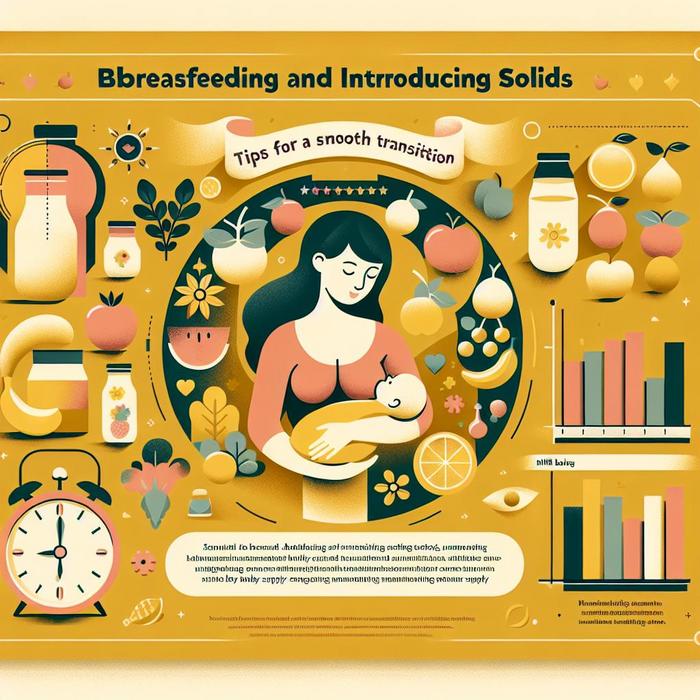Breastfeeding and Solids Tips: The Starting Line
Introducing solid foods while continuing to breastfeed your baby can seem like a daunting challenge. It’s a stage of life that often brings many questions with it, and can seem quite overwhelming. However, with the right guidance and information, managing feeding schedules, maintaining supply, and ensuring optimal baby nutrition doesn’t have to be a source of stress. Here’s how to make the transition a smooth one.
How and When to Start
The World Health Organization recommends exclusive breastfeeding for the first six months, and then to continue breastfeeding alongside introducing solids up to two years and beyond. So, when is the right time to start introducing solid foods? It’s a judgement call you’ll need to make based on your baby’s readiness. A good sign is when they start showing interest in your food.
- Watch for signs of readiness: reaching for your food, showing curiosity, or making chewing motions.
- Begin with baby-friendly foods that are easy to digest, such as pureed fruits and vegetables.
- Introduce one food at a time, waiting a few days before introducing another, to check for any allergic reactions.
Maintaining Your Breast Milk Supply
One common fear among mothers is that introducing solids might decrease their breast milk supply. The key is to understand that breastfeeding works on a supply-and-demand basis. The more you nurse, the more milk you produce.
- Continue to nurse or pump regularly, even as you introduce solids.
- Offer the breast before solids. This will ensure your baby gets the benefits of breastmilk before filling up on solids.
- Keep in mind, solids are a supplement and not a replacement for breastmilk at this stage.
You can find more tips on maintaining your milk supply in this helpful article from Women’s Health.
Developing a Feeding Schedule
Creating a feeding schedule that balances breastfeeding and solids can be a bit of a balancing act. It’s important to keep flexibility in mind as your baby’s appetite and needs may fluctuate from day to day.
- Always nurse before offering solids, at least for the first few months.
- Start with one meal a day, then gradually increase to two, then three meals as they get used to solids.
- Adjust the schedule according to your baby’s needs, cues, and appetite.
You can check out more on creating a happy and stimulating environment for your baby here.
Dealing with Digestive Changes
Keep in mind that introducing solid foods is likely to bring changes in your baby’s digestion. Your little one’s stools might change in color, consistency, and frequency. This is completely normal.
However, if your baby experiences digestive discomfort, like excessive gas or constipation, you might need to make some adjustments. Here are a few quick fixes for common baby aches and pains on our blog.
Introducing solids while continuing to breastfeed is an exciting phase for both you and your little one. It’s a time of discovery and learning, a journey into new tastes and textures. Remember, every baby is different and what works for one might not work for another. It’s all about finding what suits you and your baby best.
The Role of Breastfeeding in Transition to Solid Foods
The role of breastfeeding during this period of transition from milk to solid foods cannot be overstated. As detailed in the Centre for Disease Control and Prevention (CDC), breastfeeding can provide the necessary bridging nourishment as the baby is introduced to solid foods. Not only does it provide the needed nutrients, but it also aids in the proper functioning of the baby’s digestive system.
- For most babies, breastfeeding alongside solid food introduction can lead to smoother digestion.
- Breast milk can aid in softening hard consumables for babies, making the transition easier.
- While your baby is still getting used to solid foods, breastfeeding can continue to be the primary source of nourishment.
Observing Your Baby’s Responses
During this period, it’s important to observe your baby’s reactions to different foods. Knowing how to decipher their cues can be a great help. Here is a comprehensive guide on breastfeeding positioning and attachment which can help make this process easier for you.
- Watch for any signs of discomfort or rejection.
- Take note of any allergic reactions, such as rashes or digestive discomfort.
- Be patient and try different foods; preference for certain tastes can vary widely among infants.
Understanding the Nutritional Balance
When introducing solid foods, it is crucial to ensure that your baby is getting a balanced diet. Supplementing breastfeeding with nutritious solids isn’t just about filling their stomachs, but also about ensuring they are receiving all the essential vitamins and nutrients. The CDC’s comprehensive guide to infant nutrition can offer some helpful insights.
- Fruits and vegetables can be great starters.
- Gradually introduce proteins such as beans, lentils, and lean meat.
- Ensure the baby is getting enough iron and vitamins from the diet.
Dealing with Challenges
While introducing solid foods can be an exciting time, it can also be fraught with challenges. Understanding how to deal with these hiccups as they come up is integral to a smooth transition. For more in-depth tips on nursing and introducing solid foods, consider this essential resource from WebMD.
- If your baby refuses a particular solid food, don’t force it. Try again another time or introduce a different food.
- If your baby shows signs of food allergies, consult your pediatrician immediately.
- If nursing becomes difficult, consider seeking advice from a certified lactation consultant.
Making the transition from breastfeeding to introducing solid foods is a significant milestone in your baby’s life. It is a new adventure filled with trials, triumphs, and lots of new tastes for your little one. By maintaining a balance of continued breastfeeding and gradual solid food introduction, you can ensure a healthy, happy, and well-nourished baby.







